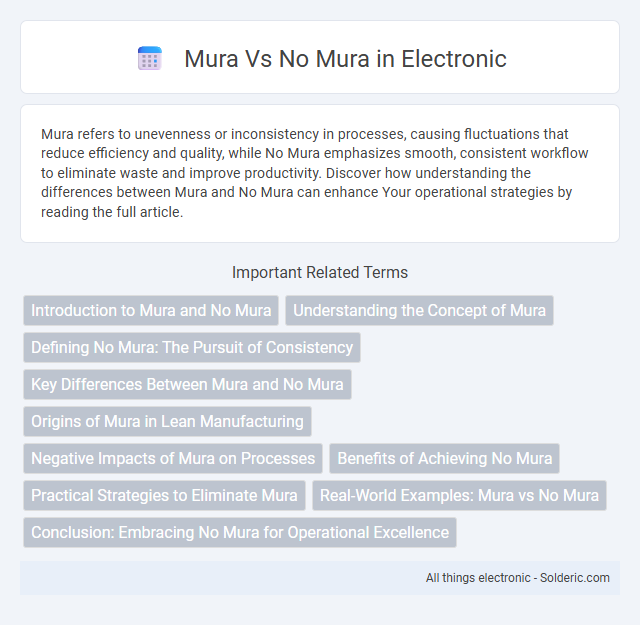Mura refers to unevenness or inconsistency in processes, causing fluctuations that reduce efficiency and quality, while No Mura emphasizes smooth, consistent workflow to eliminate waste and improve productivity. Discover how understanding the differences between Mura and No Mura can enhance Your operational strategies by reading the full article.
Comparison Table
| Aspect | Mura | No Mura |
|---|---|---|
| Definition | Unevenness or inconsistency in process flow or output. | Consistent, smooth, and uniform process flow and output. |
| Cause | Variations in workload, operator skill, or equipment usage. | Balanced workload and standardized processes. |
| Effect on Production | Leads to inefficiencies, delays, and quality issues. | Promotes efficiency, timely delivery, and high quality. |
| Impact on Inventory | Causes overstocking or shortages due to irregular flow. | Maintains optimal inventory levels through steady flow. |
| Role in Lean Manufacturing | One of the 3 Muda (wastes) targets for elimination. | Goal state to achieve in lean production systems. |
| Example | Fluctuating daily production output causing bottlenecks. | Consistent daily output with balanced workload distribution. |
Introduction to Mura and No Mura
Mura refers to unevenness or inconsistency in production processes, causing fluctuations in workload that lead to inefficiencies and waste. No Mura emphasizes creating a balanced flow by leveling out production activities to maintain steady operations and improve overall efficiency. Your ability to identify and eliminate Mura is crucial for achieving smooth, predictable workflows and enhancing productivity.
Understanding the Concept of Mura
Mura refers to unevenness or inconsistency in production processes that can lead to inefficiencies and waste, whereas No Mura emphasizes smooth and balanced workflows to optimize operational performance. Understanding Mura involves recognizing fluctuations in workload, resource allocation, and scheduling that cause variability and disrupt steady output. By identifying and eliminating Mura, your organization can achieve higher productivity, reduce bottlenecks, and maintain consistent quality in manufacturing or service delivery.
Defining No Mura: The Pursuit of Consistency
No Mura represents the elimination of unevenness or irregularity in production processes, aiming for steady, predictable workflows that enhance efficiency and quality. This pursuit of consistency minimizes fluctuation in demand and output, stabilizing resources and reducing waste, which is critical for lean manufacturing success. By contrast, Mura denotes the variability that disrupts smooth operations, making No Mura a fundamental principle for maintaining balance and continuous improvement in production systems.
Key Differences Between Mura and No Mura
Mura refers to unevenness or inconsistency in processes, leading to irregular workloads or quality fluctuations, while No Mura signifies a balanced and stable workflow with uniform demand and output. Key differences between Mura and No Mura include the variability in production rates and resource utilization, where Mura causes inefficiencies and bottlenecks, whereas No Mura promotes smooth operations and consistent quality. Ensuring No Mura in your processes can optimize performance, reduce waste, and enhance overall productivity.
Origins of Mura in Lean Manufacturing
Mura, a core concept in Lean Manufacturing, originates from the Japanese word meaning "unevenness" or "irregularity" in production processes. It is identified as one of the three primary wastes, along with Muda (wastefulness) and Muri (overburden), that Toyota Production System (TPS) targets to enhance operational efficiency. Addressing Mura helps in stabilizing workflow, reducing fluctuations, and achieving smooth production cycles essential for Lean performance.
Negative Impacts of Mura on Processes
Mura, characterized by unevenness and irregularity in processes, leads to inefficiencies such as increased operational costs, higher defect rates, and extended lead times. This variability disrupts workflow balance, causing bottlenecks and resource underutilization that hinder overall productivity. Failure to address Mura results in diminished customer satisfaction due to inconsistent quality and delayed deliveries.
Benefits of Achieving No Mura
Achieving No Mura eliminates inconsistencies in production flow, leading to smoother operations, reduced waste, and enhanced quality control. Your manufacturing processes become more predictable and efficient, resulting in lower operational costs and higher customer satisfaction. This balanced approach supports sustainable growth by minimizing overburden and uneven workloads.
Practical Strategies to Eliminate Mura
Implementing standardized workflows and balancing production cycles are practical strategies to eliminate Mura, the variability in manufacturing processes that disrupts efficiency. Utilizing real-time data monitoring systems helps identify irregularities quickly, allowing for immediate corrective actions to maintain steady operations. Cross-training employees enhances flexibility, ensuring consistent output and minimizing fluctuations caused by uneven skill distribution.
Real-World Examples: Mura vs No Mura
Mura, representing unevenness or variability in processes, often leads to inconsistent product quality and fluctuating production times, as seen in manufacturing lines with unpredictable machine speeds or staffing levels. In contrast, No Mura emphasizes smooth, consistent workflows, reducing waste and enhancing efficiency, exemplified by Toyota's lean production system where standardized tasks minimize variability. Your ability to identify and eliminate Mura in operations directly improves reliability and customer satisfaction through more predictable outputs.
Conclusion: Embracing No Mura for Operational Excellence
Adopting No Mura principles eliminates uneven workloads and reduces process variability, driving consistent production flow and improving overall efficiency. Your organization benefits from enhanced resource allocation and minimized waste, leading to higher quality output and cost savings. Embracing No Mura is essential for achieving operational excellence and sustaining long-term competitive advantage.
Mura vs No Mura Infographic

 solderic.com
solderic.com